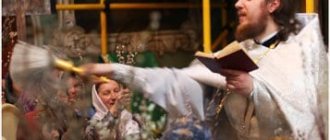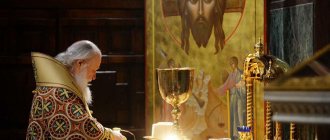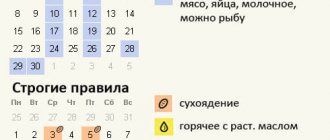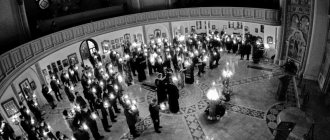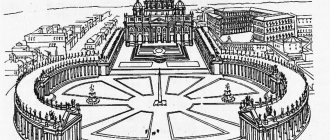The concept of the Mother of God holidays in Orthodoxy
In the Orthodox church calendar there are dates that are dedicated to special veneration of the Virgin Mary. The beginning of the veneration of various events from the earthly life of the Mother of God can be traced back to antiquity, but the greatest influence on the establishment of certain memorable dates dedicated to the Queen of Heaven was the beginning of the celebration of the Nativity of Christ, which was set for December 25. This definition of honoring the birth of Jesus became a liturgical statement of the dogma of the Incarnation.
Memories of the events of the Savior’s birth were closely intertwined with the glorification of his earthly mother, Mary, which was reflected in the sermons that were heard in churches these days.
Cathedral of the Blessed Virgin Mary - holiday January 8: categorical prohibitions.
Previously, the holiday was considered even more important for women than Christmas. After all, its very essence was dedicated to the role and merits of the fair sex on Earth. There was a strict ban on performing any work for pregnant women and their other halves. This could lead to physical disabilities in the baby. But a similar taboo applied to household work - washing, cleaning and sewing.
It was considered bad manners to eat jelly on January 8th. Otherwise, your actions will bring the dead man into the house. Also, even in case of emergency, no ropes were bought that day. Violation of this prohibition could lead to the appearance of strangled and hanged people in your family.
List of Mother of God holidays
In the modern Orthodox Church there is a list of holidays that relate to the Mother of God. Each memorable day has its own characteristics of holding services and reading prayers.
Nativity of the Blessed Virgin Mary
One of the most significant events in the Orthodox religion, the Nativity of the Virgin Mary, is celebrated by Christians on September 21. Despite the fact that this date is one of the most revered among Orthodox Christians, the event is not reflected in any Gospel of the canonical Bible. All information on the basis of which the memorial date was approved was taken from the works of the holy fathers of the church, which complement the Holy Scriptures.
Joachim and his wife were already advanced in age and could not have children, and the priest forbade the elder to make sacrifices to the Lord in the temple.
Desperate, he withdrew into the desert and began to pray fervently. At this time, an angel appeared to him and said that his request had been heard in heaven, and that he and his wife would soon become parents, despite their age. Rejoicing at this news, Joachim and his wife promised that they would dedicate the born child to the Lord. This is what they did, when their daughter was born, whom they named Mary, they brought her to the temple, where she was raised until her marriage to Joseph.
For the first time, the Nativity of the Virgin Mary began to be celebrated by Christians in the 5th century. Icons depicting the Virgin Mary appeared later - by the 10th century. In the center, the icon painters depicted the mother of the Mother of God, Anna, and next to her were servants and women who came to worship the future Mother of the Lord.
Memorial Day of Saints Joachim and Anna, parents of the Virgin Mary
The Mother of God holidays also include a memorable date when the parents of the Queen of Heaven, Joachim and Anna, are glorified. The saints are remembered on September 22, and special services are held in churches on this day. After they gave their daughter to be raised in the temple, they spent the rest of their days in prayer and died at an advanced age. Joachim departed to the Lord at the age of 80, and Saint Anna two years after the death of her husband, which she spent at the temple next to her daughter.
Presentation of the Blessed Virgin Mary into the Temple
Another major feast of the Mother of God is the Entry into the Temple of the Most Holy Theotokos; it is popularly called the Third Most Pure Mother of God. When Mary was three years old, her parents fulfilled their vow and brought her to the temple to dedicate the child to the Lord. At the entrance the girl was met by the high priest Zechariah and was very surprised by the child’s behavior. As soon as Mary was placed on the steps of the temple, she immediately, without looking back, ran inside, forgetting about her parents.
Celebrated Introduction On December 4, according to folk traditions, on this day fishermen went out fishing for the last time, since frosts soon bound the rivers and lakes, and this was no longer possible. Despite the fact that the holiday falls during Lent, a slight relaxation was made on this day - it was allowed to eat fish and even drink a little church wine.
Conception of the Blessed Virgin Mary by Righteous Anna
The Orthodox world celebrates the conception of the righteous Anna of the Most Holy Theotokos on December 22. People call this day Winter Anna, or Dark Anna. Since ancient times, this holiday has been held in special esteem by pregnant women. Saint Anne, who was destined to become the mother of the Virgin Mary and the grandmother of Jesus Christ, was born in the 1st century BC. e. in the family of the priest Matthan, who came from the tribe of Levi. Anna's husband, Joachim, came from the tribe of Judah; according to prophecy, it was from him that the Savior of mankind was to be born.
The couple lived in Nazareth of Galilee, were pious and donated most of their income to churches and the poor. However, by God's special providence, the couple did not have children for 50 years. Anna and Joachim were very worried about their childlessness, since among the Israeli people this was considered a great misfortune and punishment from the Lord for their sins. On one holiday, a married couple went to the temple to make sacrifices to the Almighty and ask for blessings, but the high priest refused to accept the gifts. Distressed, the saint went into the desert and spent 40 days there in fervent prayers, calling on the mercy of the Almighty.
Anna considered herself the main culprit of the misfortune that befell their family, and tearfully prayed to the Lord to send them a child. One day, among the branches of a tree, she saw a nest with fledged chicks and promised God that she would dedicate the gifted child to him. And as soon as she uttered these words, an Angel appeared to her and announced that her request had been heard by the Almighty, and soon she would have a child, through whom all the tribes of the earth would be blessed.
Cathedral of the Blessed Virgin Mary
The celebration of the Cathedral of the Blessed Virgin Mary takes place on January 8, immediately after the Nativity of Christ. Glorifying the Queen of Heaven on this day, the Orthodox Church remembers the flight of the Holy Family to Egypt from the evil King Herod, who ordered the extermination of all male babies in Israel.
The establishment of the celebration of the Council of the Blessed Virgin Mary dates back to ancient Christian times. At the end of the 4th century, Blessed Aurelius Augustine and Epiphanius of Cyprus in their writings mentioned the need to combine praise of the Savior with praise of the Virgin Mary, who gave birth to him. The official date of the holiday was approved at the Ecumenical Council, which took place in 680. In Rus', the first icons dedicated to the Cathedral of the Blessed Virgin Mary appeared in the 14th century. On them, the Virgin Mary was depicted sitting on a throne with the Divine Child in her arms. She is surrounded by shepherds, wise men and angels.
Annunciation
The Annunciation is considered one of the most ancient feasts of the Mother of God. On this day, Orthodox believers remember how the Archangel Gabriel announced to the Virgin Mary that she would conceive and give birth to a Son, who would take upon himself the sins of all mankind. Throughout the Christian world, this holiday began to be celebrated around the middle of the 7th century. At the same time, the date of celebration was set - April 7. It was calculated from the Nativity of Christ, since it was believed that Mary conceived on the day when she heard the good news from the archangel.
In Rus', the Annunciation began to be celebrated later - around the 10th century. Today this day is considered the date of the incarnation of the Savior; the Orthodox Church remembers this sacrament and glorifies the Queen of Heaven, who served the salvation of all mankind.
Saturday Akathist
On Saturday, the fifth week of Great Lent, the Orthodox Church solemnly proclaims the praise of the Akathist to the Most Holy Theotokos. This holiday was established in the 9th century in honor of the repeated deliverance of Constantinople from enemy invasions through the intercession of the Queen of Heaven.
The founder of the city, Constantine the Great, dedicated it to the Blessed Virgin Mary and revered her as the patroness of the capital. At this time, churches were erected in Constantinople in honor of the Mother of God. When the combined forces of the Hagarians and Persians moved towards the city, a terrible storm arose, which scattered and sank the ships of the invaders. That night, the people stayed in the Blachernae Church and proclaimed a victorious non-seated song (akathist) to the Heavenly Defender. This was the beginning of the establishment of a holiday in honor of the miraculous deliverance of the city from the attackers.
Day of consecration of the Church of the Blessed Virgin Mary at the Life-Giving Spring in Constantinople
Every year on Friday of Holy Week, all Orthodox churches celebrate the feast of the renewal of the Church of the Mother of God, which is called the “Life-Giving Source.” According to established tradition, on this day the service of the Blessed Virgin Mary is added to the Easter service. This celebration was established in honor of the restoration of the Constantinople temple, called the “Life-Giving Source,” as well as the miracles that took place in this place.
The miraculous icon of the same name was greatly revered in Rus', and from the 16th century a custom arose to dedicate springs located on the territory of churches and monasteries to this image.
Position of the robe of the Blessed Virgin Mary in Blachernae
During the reign of Emperor Leo the Great, the king's close associates, the brothers Candide and Galbius, decided to go to Palestine to venerate the holy places. Near Nazareth, in a small village, they stopped for the night with a Jewish woman. They noticed the smoking incense in her home and the burning candles. The woman did not want to answer for a long time, but then she admitted that she kept the Robe of the Virgin Mary, from which many miracles and healings occur. Before her death, the Virgin Mary gave part of her clothes to one girl, and so, from generation to generation, the shrine was kept in this family.
The brothers secretly replaced the ark with the robe and took it to Constantinople, where they kept it in their house. However, multiple miracles that occurred from Riza forced them to reveal the truth and talk about the shrine. Since then, it was placed in the Church of the Virgin Mary, built on the shores of the Blachernae Gulf. The Orthodox Church celebrates this feast of the Mother of God on July 15th.
Dormition of Righteous Anna
The day of the death of the mother of the Virgin Mary, St. Anne, is also included in the list of Mother of God holidays. The Orthodox Church celebrates the Feast of the Dormition of Righteous Anna annually on August 7th. The saint is considered the patroness of all women and mothers. On this day, it is customary to ask the righteous woman for healing from infertility. In the folk calendar, this date was called Anna of the Summer, or Anna of the Cold.
Dormition of the Blessed Virgin Mary
The Dormition of the Virgin Mary is celebrated in Orthodoxy on August 28. This holiday is preceded by a very strict Dormition Fast. The date symbolizes the day of the end of the earthly journey of the Mother of the Lord. There is a version that three days before her death, the Mother of God received news from the Archangel Gabriel about her imminent transition to eternity. As a sign of confirmation of his words, the archangel handed her a palm branch.
On this holiday, it is customary in Orthodoxy to bless ears of wheat from the new harvest in churches and pray for their loved ones.
Position of the Belt of the Blessed Virgin Mary in Chalcopratia
According to legend, the Mother of God wove the belt with her own hands and constantly wore it during her lifetime. Before their death, all the apostles gathered around the Blessed Virgin Mary, except Thomas, who came to Jerusalem only three years after the Dormition of the Queen of Heaven. As a consolation, the Mother of God sent down her belt to him from heaven.
In honor of the relic, a special holiday has been established in the Orthodox Church, which is celebrated on August 31.
Weather signs
The holiday, when the image of the Kazan Mother of God is honored, is associated with the change of seasons. People say: before the holiday it is not winter, and after it is not autumn.
Borrego Ruiz, “Autumn” Photo: artchive.ru
Quite a lot of weather signs are associated with this day among the people. Here are some of them:
- Rainy day - the bad weather will be prolonged.
- Foggy during the day - it may be warm in November.
- A fine and sunny day promises colder temperatures in the coming days.
Since ancient times, people have associated rain on the feast of the Kazan Icon with the tears of the Mother of God, which she sheds for all people, praying to her Son for help to all who need it.
